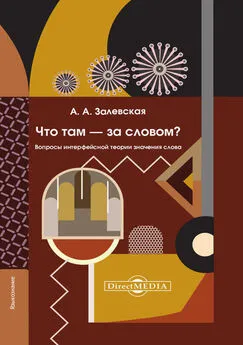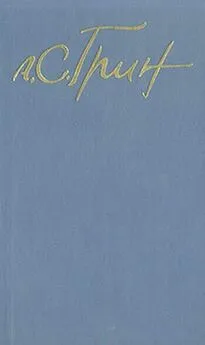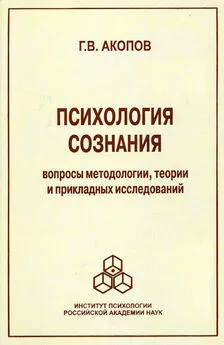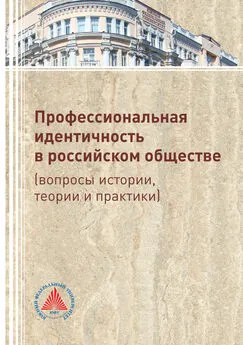Александра Залевская - Что там – за словом? Вопросы интерфейсной теории значения слова
- Название:Что там – за словом? Вопросы интерфейсной теории значения слова
- Автор:
- Жанр:
- Издательство:Литагент «Директмедиа»1db06f2b-6c1b-11e5-921d-0025905a0812
- Год:2014
- Город:Москва-Берлин
- ISBN:978-5-4458-3612-4
- Рейтинг:
- Избранное:Добавить в избранное
-
Отзывы:
-
Ваша оценка:
Александра Залевская - Что там – за словом? Вопросы интерфейсной теории значения слова краткое содержание
Как мы понимаем друг друга? Какую роль при этом играет слово? Что требуется для того, чтобы слово стало полным смысла, т.е. «живым», помогающим понять и пережить то, на что оно указывает или намекает? Цель этой книги – показать: главное заключается в том, что лежит ЗА СЛОВОМ в личном и социальном опыте (без этого последовательность звуков или графем остаётся «мёртвой»). Интерфейсная теория значения даёт объяснение двойной жизни слова и раскрывает посредническую роль значения в двух позициях: (I) между обществом и личностью; (II) между дискретной языковой единицей и тем, что лежит за словом во внутреннем контексте – голограмме образа мира индивида как результате переработки вербального и невербального опыта познания и общения. Книга полезна широкому кругу читателей, интересующихся вопросами познания мира, общения, взаимопонимания, адаптации к наличной ситуации, овладения языком и т.д.
Что там – за словом? Вопросы интерфейсной теории значения слова - читать онлайн бесплатно ознакомительный отрывок
Интервал:
Закладка:
19. Палкин А. Д .Толковый словарь русского языка глазами детей. – М.: НОУ МЭЛИ, 2004. – 360 с.
20. РАС :Русский ассоциативный словарь / Ю. Н. Караулов, Ю. А. Сорокин, Е. Ф. Тарасов, Н. В. Уфимцева, Г. А. Черкасова. – В 6 кн. – М.: «Помовский и партнеры»; ИРЯ РАН, 1994–1998.
21. Русский ассоциативный словарь : ассоциативные реакции школьников 1-11 классов: в 2 т. / В. Е. Гольдин, А. П. Сдобнова, А. О. Мартьянов. – Саратов: Изд-во Сарат. ун-та, 2011. – Т.1. – 500 с.
22. Славянский ассоциативный словарь: русский, белорусский, болгарский, украинский / Н. В. Уфимцева и др. – М.: МГЛУ; Ин-т языкознания РАН, 2004. – 792 с.
23. САНРЯ: Словарь ассоциативных норм русского языка / под ред. А. А. Леонтьева. – М.: Изд-во Моск. ун-та, 1977. – 201 с.
24. Соколова Т.В. Ассоциативный словарь ребенка: В 2-х ч. – Архангельск: Изд-во Поморск. междунар. пед. ун-та, 1996. – Ч.1 – 165 с; Ч.2 – 305 с.
25. Титова Л.Н . Киргизско-русский ассоциативный словарь. – Фрунзе: «Мектеп», 1975. – 96 с.
26. Ульянов Ю. Е .Латышско-русский словарь – Рига: «Зинатне», 1988. – 187 с.
27. Филиппович Ю.Н., Черкасова Г.А., Дельфт Д . Ассоциации информационных технологий: эксперимент на русском и французском языках. – М.: Изд-во МГУП, 2002. – 304 с.
28. Цiтова А.I . Асацыятыўны слоўнiк беларускай мовы. – Мiнск: Выд-ва БДУб 1981. – 144 с.
29. Altarriba, J., Bauer, L.M. & Benvenuto, C . Concreteness, context availability, and imageability ratingsand word associations for abstract, concrete, and emotional words // Behavior Research Methods, Instruments, & Computers. – 1999. – Vol. 31. – Pp. 578–602.
30. Ashcraft, M. Property norms for typical and atypical items from 17 categories: A description and discussion // Memory and Cognition. – 1978. – Vol. 6 (3). – Pp. 227–232.
31. Balota, D.A., Cortese, M.J., Hutchison, K.A., Neely, J.H., Nelson, D., Simpson, G.B. & Treiman, R . The English Lexicon Project: A web-based repository of descriptive and behavioral measures for 40,481 English words and nonwords (2002). Accessed September 30, 2004, on Washington University Web site: http://elexicon.wustl.edu.
32. Balota, D.A., Pilotti, M., & Cortese, M.J . Subjective frequency estimates for 2.938 monosyllabic words // Memory & Cognition. – 2001. – Vol. 29. – Pp. 639–647.
33. Barca, L., Burany, c., & Arduino, L.S . Word naming times and psycholinguistic norms for Italian nouns // Behavior Research Methods, Instruments, & Computers. – 2002. – Vol. 34. – Pp. 424–434.
34. Battig, W.F., & Montague, W.E . Category norms for verbal items in 56 categories: A replication and extension of the Connecticut category norms // Journal of Experimental Psychology. – 1969. – Vol. 80. – N.3. – Pt.2. – Pp. 1–16.
35. Bellezza, F.S., Greenwald, A.G., & Banaji, M.R . Words high and low in pleasantness as rated by male and female college students // Behavior Research Methods, Instruments, & Computers. – 1986. – Vol. 18. – Pp. 299–303.
36. Bird, H., Franklin, S., & Howard, D . Age of acquisition and imageability ratings for a large set of words, including verbs and function words // Behavior Research Methods, Instruments, & Computers. – 2001. – Vol. 33. – Pp. 73–79.
37. Bradley, M.M. & Lang, P.J . Affective norms for English words (ANEW): Instruction manual and affective ratings: Technical Report C–1. – University of Florida, The Center for Research in Psychology, 1999 [Электронный ресурс].
38. Brown, W.P., & Ure, D.M.J . Five rated characteristics of 650 word association stimuli // British Journal of Psychology. – 1969. – Vol. 60. – Pp. 233–249.
39. Burke, D.M., Peters, L. & Rose, M.H . Word association norms for young and older adults // Social and Behavioral Science Documents. – 1987. – Vol. 17 (2). [Электронный ресурс].
40. Carroll, J.B. & White, M.N . Age of acquisition norms for 220 pictureable nouns // Journal of Verbal Learning & Verbal Behavior. – 1973. – Vol. 12. – Pp. 563–576.
41. Clark, J.M., & Paivio, A. Extensions of the Pavio, Yulle, and Madigan (1968) norms // Behavior Research Methods, Instruments, & Computers. – 2004. – Vol. 36. – Pp. 371–383.
42. Cortese, M., & Fuggett, A . Imageability ratings for 3,000 monosyllabic words // Behavior Research Methods, Instruments, & Computers. – 2004. – Vol. 36. – Pp.384–387.
43. De Deyne, S. & Storms, G . Word associations: Norms for 1,424 Dutch words in a continuous task // Behavior Research Methods. – 2008a. – Vol. 40 (1). – Pp. 198–205.
44. De Deyne, S. & Storms, G . Word associations: Network and semantic properties // Behavior Research Methods. – 2008b. – Vol. 40(1). – Pp.213–231.
45. De Groot, A.M.B . Mondelinge woordassociatienomen: 100 woordassociaties op 460 Nederlandse zelfstanige naamwoorden [Oral word association norms: 100 word associations to 460 Dutch nouns]. – Lisse, The Netherlands: Swets & Zeitlinger, 1980.
46. de la Haye, F . Normes d’associations verbales chez des enfants de 9, 10 et 11 ans et des adults // L’Année Psychologique. – 2003. – Vol. 103. – Pp. 109–130.
47. Entwisle, D.R . Word associations of young children. – Baltimore: The John Hopkins Press, 1966.
48. Fernández, A., Diez, M., Alonso, A., & Beato, M . Free-Association Norms for the Spanish Names of the Snodgrass and Vanderwart Pictures // Behavior Research Methods, Instruments, & Computers. – 2004 – Vol. 36(3). – Pp. 577–583.
49. Ferrand, L. & Alario, F. – X . French word association norms for 366 names of objects // L’Année Psychologique. – 1998. – Vol. 98(4). – Pp. 659–709.
50. Friendly, M., Franklin, P.E., Hoffman, D., & Rubib, D.C . The Toronto Word Pool: Norms for imagery, concreteness, orthographic variables, and grammatical usage foe 1,080 words // Behavior Research Methods, Instruments, & Computers. – 1982. – Vol. 14. – Pp. 375–399.
51. Gerrоw, J.R. & Pо11iо, E.R. Word association, frequency of occurrence, and semantic differential norms for 360 stimulus words: The University of Tennessee. Dept. of Psychology. Technical Report No.1. April, 1965.
52. Ghyselinck, M., Custers, R. & Brysbaert, M . Age-of-acquisition ratings for 2322 Dutch words from 40 different semantic categories // Psychologica Belgica. – 2003. – Vol.43. – Pp. 181–214.
53. Ghyselinck, M., De Moor, W. & Brysbaert, M . Age-of-acquisition ratings for 2816 Dutch four– and fiveletter nouns // Psychologica Belgica. – 2000. – Vol.40. –Pp. 77–98.
54. Gilhooly, K.J. & Logie, R.H . Age of acquisition, imagery, concreteness, familiarity and ambiguity measures for 1944 words // Behavior Research Methods & Instrumentation. – 1980. – Vol. 12. – Pp. 395–427.
55. Guida, A., & Lenci, A . Semantic properties of word associations to Italian verbs // Italian Journal of Linguistics. – 2007. – Vol. 19. – Pp. 293–326.
56. Hamp, B., & Feldweg, H . GermaNet – a lexical-semantic net for German // Proceedings of the ACL Workshop on Automatic Information Extraction and Building Lexical Semantic Resourses for NLP Applications. – Madrid, Spain, 1997. – Pp. 9–15.
57. Hirsh, K.W. & Tree, J . Word association norms for two cohorts of British adults // Journal of Neurolinguistics. – 2001. – Vol. 14(1). – Pp. 1–44.
58. Howard, D.V . Restricted word association norms for adults between the ages of 20 and 80 // JSAS Catalog of Selected Documents in Psychology. – 1980. – Vol. 10. – № 6.
59. Izura, C., Hernάndez-Muňoz, M., & Ellis, A.W . Category norms for 500 Spanish words in five semantic categories // Behavior Research Methods. – 2005. – Vol. 37. – Pp. 385–397. [Электронный ресурс] www.psychonomic.org/archive
60. . Jenkins, J. The 1952 Minnesota word association norms // Postman, L. & Keppel, G . (Eds.). Norms of Word Association. – New York; London:: Academic Press, 1970.
61. Jenkins, J., & Russell, W.A . Systematic changes in word association norms: 1910 – 1952 // Journal of Abnormal and Social Psychology. – 1960. – Vol. 60.
62. Joyce, T . Constructing a large-scale database of Japanese word associations // Glottometrics. – 2005. – Vol. 10. – Pp. 82–98.
63. Kent, G.H, & Rosanoff, A.J . A study of associations in insanity. I. Association in normal subjects // American Journal of Insanity. – 1910. – Vol. 67. – Pp. 37–96; 317–390.
64. Kerr, N.H., & Johnson, T.H . Word norms for blind and sighted subjects: Familiarity, concreteness, meaningfulness, imageability, imagery modality, andword association // Behavior Research Methods, Instruments, & Computers. – 1991. – Vol. 23. – Pp. 461–485.
65. Kiss, G., Armstrong, C., Milroy, R. & Piper, J . The Associative Thesaurus of English. – Edinburgh: University of Edinburgh, MRC Speech and Communication Unit, 1972. – 1539 p.
66. Kurcz, I . Polskie normy powszechności skojarzeń swobodnych na 100 słow z listy Kent-Rosanoffa // Studia psychologiczne. – Warzawa, 1967. – T. VIII (Nadbitka). – 255 s.
67. Lahl, O., Gőritz, A.S., Pietrowsky, R. & Rosenberg, J . Using the World-Wide Web to obtain large-scale word norms: 190,212 ratings on a set of 2,654 German nouns // Behavior Research Methods. – 2009. – Vol. 41 (1). – Pp. 13–19.
68. Lambert, W.E. & Mоогe, N. Word-association responses: Comparisons of American and French monolinguals with Canadian monolinguals and bilinguals // Journal of Personality and Social Psychology, 1966. – Vol. 3. – Pp. 313–320.
69. Magyar verbális asszociáciόk 1 [Hungarian Verbal Associations 1 / Ed. By Ballό, L.]. – Szeged, Budapest, Debrecen: Juhász Gyula Tanárképzõ Fõiskola, 1983. – 210 p.
70. Magyar verbális asszociáciόk 2 [Hungarian Verbal Associations 2 / Ed. By Ujvari, C.]. – Szeged, Budapest, Debrecen: Juhász Gyula Tanárképzõ Fõiskola, 1985. – 204 p.
71. Maršálová, L . Slovno-associačné normy II. V–IX trieda ZDŠ a vysoká škola. – Bratislava: Univerzita Komenského v Bratislave, 1974. – 497 s.
72. Marques, J.F., Fonseca, F.L., Morais, A.S., & Pinto, I.A . Estimated age of acquisition norms for 834 Portuguese nouns and their relation with other psycholinguistic variables // Behavior Research Methods. – 2007. – Vol. 39. – Pp. 439–444.
73. McEvoy, C.l. & Nelson, D.L . Category name and instance norms for 106 categories of various sizes // American Journal of Psychology. – 1982. – Vol. 95. – Pp.581–634.
Читать дальшеИнтервал:
Закладка:







